| YJ-8 (C-80X) SERIES ANTI-SHIP MISSILES
中国YJ-8(C-80X)系列反舰导弹 Date:2017-02-04 Source:Internet By:Globalmil Viewed: |
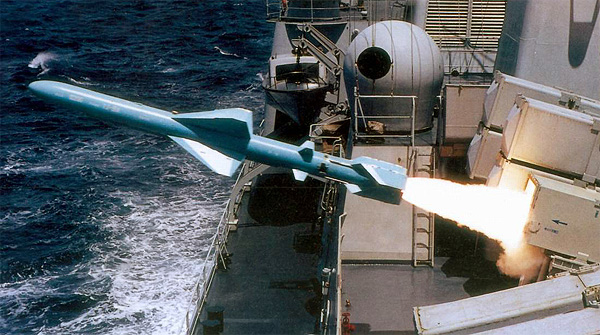
The YJ-8 series anti-ship missiles provide a common missile for air, ship, land, and submarine launches. It is equipped by most of the PLA Navy’s surface combatants commissioned after the early 1990s.
YJ-8系列反舰导弹提供一种通用导弹给空中、舰艇、陆地和潜水艇发射。在1990年早期之后服役,它被PLA海军的大多数水面战舰装备。
The YingJi-8 (YJ-8, NATO Codename: CSS-N-4 Sardine) series anti-ship missiles are developed by China HaiYing Electro-Mechanical Technology Academy (CHETA, also known as 3rd Aerospace Academy) located in the southwest suburbs of Beijing. The YJ-8 series missiles provide the PLA Navy with a common missile for air, ship, land, and submarine launches. The missile is sea-skimming, active radar guidance. The improved YJ-82 and YJ-83 (C-802/803, NATO Codename: CSS-N-8 Saccade) introduced in the 1990s feature extended range.
“鹰击”(YingJi)-8(YJ-8,北约代号:CSS-N-4“沙丁鱼”)系列反舰导弹由位于北京西南市郊的中国“海鹰”(HaiYing)机电技术研究院(CHETA,也即是第三航空宇宙研究院)发展。YJ-8系列导弹提供给PLA海军一种通用导弹用于空中、舰艇、陆地和潜水艇发射。导弹是掠海、主动雷达制导。改良的YJ-82和YJ-83(C-802/803,北约代号:CSS-N-8 Saccade)在1990年推出特点是增加射程。

The early basic variant YJ-8 features a maximum range of 42km. The missile has fixed wings and stabilising fins, resulting an oversized box launcher.
早期基本型YJ-8以最大射程42公里。导弹采用固定翼和稳定翼,因此在一个特大号箱体发射装置内。
PROGRAMME
计划
3rd Aerospace Academy (now CHETA) began to develop a new generation YJ-8 anti-ship missile in the early 1970s. Unlike the existing Chinese indigenous anti-ship missiles, which were all derived from the Soviet 544 (SS-N-2 Styx) anti-ship missile, the new missile was developed from scratch with certain Western influence. The YJ-8 is almost identical in length and diameter to the French Exocet anti-ship missile, and features a triple control surface similar to those found on the U.S. Harpoon. There has been speculations that the YJ-8 may have been based on Exocet this appears to be groundless.
第三航空宇宙研究院(现在的CHETA)在1970年早期开始发展一种新一代YJ-8反舰导弹。不像已有的中国自制的反舰导弹,几乎全部来源于苏联544(SS-N-2“冥河”)反舰导弹,新的导弹在某些西方影响力下从头发展。YJ-8几乎在长度和直径方面与法国飞鱼(Exocet)反舰导弹相同,而且采用类似美国“鱼叉”导弹的三组控制面。已经有推测YJ-8可能以飞鱼(Exocet)为基础,这似乎是没有根据的。
The YJ-8 development programme was totally sponsored by the 3rd Aerospace Academy with no state funding available. The solid rocket motor for the missile was successfully tested in October 1973. The first test fire was conducted in the early 1980s, but two out of the three missiles launched lost control before reaching the targets. The modified YJ-8 passed its final design test in September 1985 directly hitting targets in all six test launches. The design certificate of this missile was approved in 1987 and was first deployed onboard the PLA Navy Type 053H2 (Jianghu-IV class) frigate. The missile was also promoted to the foreign market under the export name C-801.
YJ-8发展计划完全由第三航空宇宙研究院资助,并且没有得到国家投资。用于导弹的固体火箭发动机在1973年10月成功测试。第一次测试发射在1980年早期内进行,但是二次失去三枚导弹,在发射后到达目标之前失去了控制。被修改的YJ-8在1985年9月通过了它的最后设计测试,在全部六次试射中直接击中目标。这一种导弹的设计证明书在1987年被核准,并且在舰载上被首先部署到PLA海军053 H2型(“江卫”(Jianghu)-IV级)护卫舰。导弹也被推销到国外市场,出口型命名为C-801。
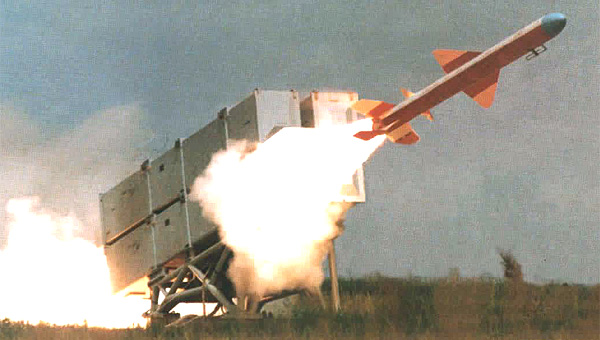
The improved YJ-81 (C-801) in land firing test. The variant features an extended range of 80km and foldable wings to reduce the size of the missile launcher.
改进型YJ-81(C-801)在陆射测试。改型特点是增程到80公里和可折弹翼减少导弹发射装置尺寸。
3rd Aerospace Academy later developed a range of improved models based on the YJ-8, including the extended range variants YJ-81 (C-801A, with foldable wings) and YJ-83 (C-803), the shore-to-ship variant YJ-82 (C-802 NATO Codename: CSS-N-8 Saccade), the air launched variants YJ-8K (C-801K) and YJ-83K (C-803K), and the submarine launched variant (YJ-8Q/C-801Q?), and land-attack cruise missile variant (YJ-85/C-805?).
第三航空宇宙研究院稍后发展了基于YJ-8的广泛改进型,包括增程改型YJ-81(C-801A,采用可折叠弹翼)和YJ-83(C-803),岸对舰改型YJ-82(C-802北约代号:CSS-N-8 Saccade),空射改型YJ-8K(C-801K)和YJ-83K(C-803K),潜射改型(YJ-8Q/C-801Q?),对陆-攻击巡航导弹改型(YJ-85/C-805?)。
MISSILE
导弹
The YJ-8 features a slim cylinder body with round nose, trapezoid wings and stubby fins near the end of the body. The nose section consists of a mono-pulse, high-frequency (possibly J-band) terminal guidance radar seeker with a 165kg semi-armour-piercing warhead behind it. The instrument compartment containing the guidance command processor, vertical gyro, radio altimeter and its antenna, is located in front of the rocket motor.
YJ-8特点是一个细长的圆筒形弹体和圆形头部,梯形弹翼和靠近弹体尾部的短直尾翼。前端部分由一部单脉冲、高频(可能J-波段)末段制导雷达导引头和后部的一枚165公斤半穿甲弹头组成。仪表舱包括制导指令处理机、垂直陀螺仪、无线电测高度计和它天线,位于火箭发动机前面。
The terminal guidance radar with mono-pulse system possesses high anti-jamming capabilities. The high precision radio altimeter allows the missile to have minimum-altitude flight above the sea. It uses a semi-armour-piercing anti-personnel blast warhead which relies on the missile's kinetic energy to pierce the deck of a ship, penetrate into and explode in the ship's interior. During final design flight tests, one missile sank a target ship of 10,000t displacement.
末段制导雷达采用单脉冲系统具有高反干扰能力。高精密无线电测高度计允许导弹在海面上以最低高度飞行。它使用一枚半穿甲反人员爆破战斗部,依靠导弹的动能去穿透舰艇甲板,穿入和在舰艇内部爆炸。在最后的设计飞行测试的时候,一枚导弹击沉了10,000吨排水量的一艘目标船。
YJ-82 (C-802)
The YJ-82 (C-802) was derived from the YJ-8 with extended range. The YJ-82 is externally similar to the YJ-8, and has the same solid-propellant rocket booster and guidance system. The most distinctive difference on the YJ-82 is that it employs a turbojet with paraffin-based fuel to replace the original solid rocket engine. This caused the fuselage to be extended to accommodate the extra fuel. The max range of the missile has also been extended to 120km, comparing to 40km range of YJ-8 and 80km range of YJ-81.
YJ-82(C-802)来源于YJ-8具有增加射程的特点。YJ-82外形上与YJ-8类似,而且有相同的固体推进剂火箭助推器和制导系统。在YJ-82上最有特色的差别是它采用使用烷烃-基燃料的涡轮发动机去代替最初的固体燃料火箭发动机。这造成了弹身被延长去容纳额外的燃料。导弹的最大射程也被延长到120公里,比较YJ-8的40公里射程和YJ-81的80公里射程。
The YJ-82 has only developed shore-to-ship variant launched from land-based vehicles. The missile received no order from the PLA. Following the 1991 Gulf War, Iran purchased about 60 land-launched C-802 missiles, which were deployed in coastal batteries on Qeshm Island.
YJ-82仅仅发展从陆基车辆发射的岸对舰改型。导弹没有获得来自PLA的订购。在1991年海湾战争之后,伊朗大约购买60枚陆射型C-802导弹,在Qeshm岛上的海岸炮台中部署。

The YJ-82 (C-802) land-based anti-ship missile is fitted with a turbojet engine for extended range. The missile did not enter service with the PLA, but has been successful on the international market.
YJ-82(C-802)陆基反舰导弹为增加射程配备有一个涡轮喷气发动机。导弹没有进入PLA服役,但是已经成功在国际市场上。
An improved variant designated C-802A was revealed during the Defence Systems & Equipment International (DSEI) Exhibition held in London in September 2050. This variant features an increased range of 180km.
一种改进型被指定C-802A在2005年9月伦敦的防务系统和装备国际展览会(DSEI)上被透露。这一种改型以增加射程到180公里为特色。
YJ-83 (C-803)
3rd Aerospace Academy continued to improve its YJ-82 missile in the 1990s to meet the requirements of the PLA Navy. The improved variant with further extended range of 150~200km was introduced in the mid-1990s. The YJ-82 is almost identical to the YJ-82 in appearance, but features a datalink antenna on the missile body for receiving midcourse command from airborne radar system carried by helicopters or fixed-wing aircraft. The missile is said to be supersonic but can only achieve Mach 1.5 at the final 15km of its flight. Most YJ-8 missiles onboard the PLA Navy destroyers and frigates are now replaced by the more capable YJ-83.
第三航空宇宙研究院在1990年改进它的YJ-82导弹去符合PLA海军的需求。改进型具有150~200公里的增程特点,在1990年中被推出。YJ-82的外表几乎和YJ-82相同,但特点是在导弹的弹体上有一个数据链天线用于接收来自直升飞机或固定翼飞机携带机载雷达系统的指令。导弹据说是超音速,但是仅仅在最后飞行的15公里内达到Mach 1.5。大量的在PLA海军驱逐舰和护卫舰上舰载YJ-8导弹,现在被更能力的YJ-83代替。

As the YJ-82 did not meet the requirements of the PLA navy, CHETA continued to develop an improved YJ-83 featuring a maximum range of 150~200km. The missile flies supersonic during the final stage of its flight.
YJ-82不符合PLA海军的需求,CHETA发展改进型YJ-83 ,特点是最大射程150~200公里。在它的飞行最后阶段,导弹超音速飞行。
AIR-LAUNCHED YJ-8
空射型YJ-8
The air-launched variant YJ-8, possibly designated YJ-8K (C-801K), was first tested on a modified H-5 bomber (‘Eagle’ testbed) in the mid-1980s. The missile can be launched from a range of fighter and ground attack aircraft including JH-7 and H-6. Each JH-7 or H-6 can carries four YJ-8 missiles under the wings. The improved YJ-83K was developed from the YJ-83 featuring a turbojet engine for extended range.
空射改型YJ-8,可能指定为YJ-8K(C-801K),在1980年中期首次在一架经修改的H-5轰炸机(‘鹰'测试平台)上进行发射测试。导弹能从包括JH-7和H-6多种战斗和对地攻击机发射。每架JH-7或H-6能在翼下面携带四枚YJ-8导弹。改进的YJ-83K从YJ-83发展,特点是采用一台涡轮喷气发动机用于增加射程。

The air-launched YJ-8 features a shorter missile body as a result of the removal of the solid booster. Each JH-7 fighter-bomber can carry four YJ-8 missiles under its wings.
空射型YJ-8的特点是采用一种短弹体,因此移除了固体助推器。每架JH-7战斗轰炸机能在机翼下携带四枚YJ-8导弹。
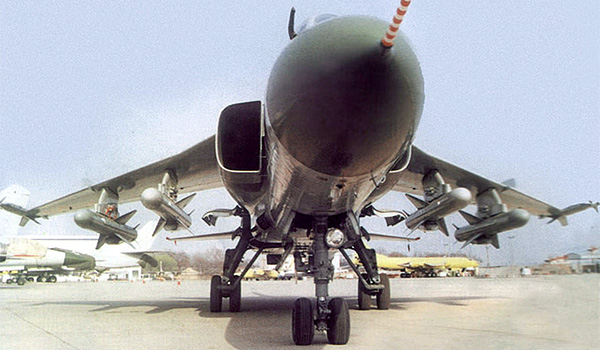
JH-7 fighter-bomber carrying four YJ-83 anti-ship missiles under its wings.
JH-7战斗轰炸机在它的机翼下携带四枚YJ-83反舰导弹。
Some reports suggested that CHETA has also developed an air-launched land-attack cruise missile (LACM) variant possibly known as YJ-85. The missile said to be fitted with GPS/TERCOM guidance and is comparable to the U.S. stand-off land attack missile (SLAM) in design and performance.
一些报道认为CHETA已经发展一种空射对陆攻击巡航导弹(LACM)改型,可能即是YJ-85。据导弹配备有全球定位系统/地形匹配(TERCOM)制导,在设计和性能上可比得上美国远距离对陆攻击导弹(SLAM)。
SUBMARINE-LAUNCHED YJ-8
潜射型YJ-8
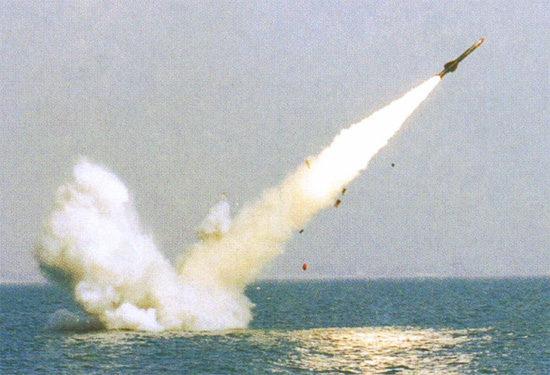
The submarine launch version of the YJ-8 missile was developed in the mid-1990s. The missile is equipped by the Type 039 (Song class) diesel-electric submarine.
潜射型YJ-8导弹在1990年中期发展。导弹在039型(“宋”级)柴电潜水艇上装备。
The PLA Navy experimentally converted a Type 033 (Romeo class) diesel-electric submarine in 1987 to carry six YJ-8 missiles in externally launch tubes. The missiles can only be launched after the submarine has surfaced. Later in the early 1990s the PLA Navy developed a new YJ-8 missile that can be launched from underwater. The missile is equipped by the Type 039 (Song class) diesel-electric submarine. The missile is carried inside a special cylinder container, which is launched from the submarine's 553mm torpedo tube. The missile is launched after the container rises to the sea surface.
PLA海军在1987年实验改装一艘033型(一种“罗密欧”(Romeo)级)柴电潜水艇,在外部发射管携带六枚YJ-8导弹。导弹只能在潜水艇浮至水面之后发射。稍后在1990年早期,PLA海军发展了一种新的YJ-8导弹,能从水面下发射。导弹在039型(“宋”级)柴电潜水艇装备。导弹在一个专用圆筒容器之内携带,从潜水艇的553毫米鱼雷管发射。导弹在容器上升到海面之后被发射。
SPECIFICATIONS
规格
长度: (YJ-8)5.814 米;(YJ-82)6.392 米
直径: 0.36 米
翼展: (YJ-8)1.18 米;(YJ-82)1.22 米
发射重量: 815 kg
弹头: 165公斤延时半穿甲高爆
推进: (YJ-8)一台固体火箭发动机,一台固体助推器;(YJ-82)一台涡轮喷气发动机,一台固体助推器
最大速度: Mach 0.9
最大射程: (YJ-8)42 公里;(YJ-81)80 公里;(YJ-82)120 公里;YJ-83(150~200 公里)
飞行高度: 20~30 米(飞行);5~7 米(攻击)
制导模式: 惯性和末段主动雷达
单发攻击概率: 75%
补充资料:中华网《C-805是YJ-8的终级型号》
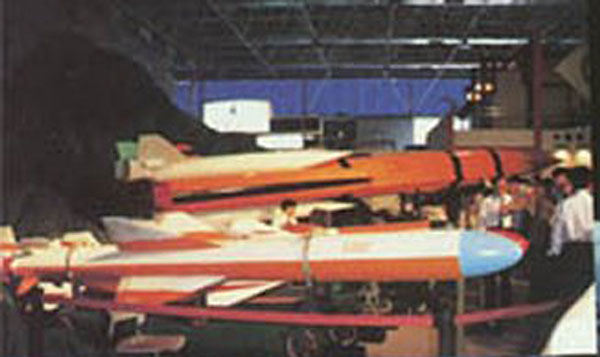
C-805是YJ-8的终级型号,装一台小型涡喷发动机和固体火箭主机,空射距离可达250公里!已从J-8D和JH-7海上发射成功。新驱是否装C-805要还要看鹰击-12的进度。YJ-12是“十。五”重点攻关项目,已完成在970上进行试验的工作。鹰击-12采用4台冲压发动机和1台固体火箭主机。该弹的特点是冲压发动机和固体火箭主机共用同一燃烧室,因此结构紧凑、燃烧效率高。YJ-12装舰的意义重大,其速度快、射程远、弹头威力大,一旦装备部队,将使海军水面舰艇首次对敌航母群构成直接威胁。其四联装圆形发射筒类似放大的“鱼叉”反舰导弹。
转自新世纪读书网《中国的『飞鱼』----YJ8》
1984年中华人民共和国国庆35周年天安门阅兵式。一把把瓦亮的刺刀,一队队簇新的战车都泛着青光。突然,天安门两侧的贵宾席上传来惊叹:“Look,Exocet!ChineseExocet!”(看!『飞鱼』!中国的『飞鱼』!)
1983年9月,海军辽西导弹实验场使用导弹快艇进行定型实验,共发射6枚导弹,全部命中目标。其中一枚直接命中一旧护卫舰改装的靶船,导弹从船舷穿出爆炸,靶船燃烧十小时后沉没。至此,历时15年的我国第一代小型固体燃料反舰导弹终于研制成功了!这种新型导弹就是中国的『飞鱼』--鹰击8号(YJ-8)反舰导弹。
无论从它的气动外形或性能系数来看,都与法国的『飞鱼』反舰导弹极为相似。YJ-8反舰导弹系统是一种多用途导弹。可装载在各种水面舰艇上使用,也可从飞机,潜艇以及岸上发射。YJ-8长仅5。814公尺,弹径为0。36公尺,全重815公斤,战斗部重168公斤。舰对舰型有效射程8至40公里,空对舰型为10至50公里。飞行速度为0。9倍音速。YJ-8仿自法国飞鱼(EXocet)MM-39。体积与第一代“蚕”(HY-2)式导弹相比有革命性的突破。它不仅适于中国空军多种现役战机和轰炸机携带,其小巧的舰载发射装置更对军舰的设计产生了重大影响。
这一影响在未来旅沪级驱逐舰和江威级护卫舰的布局上表现无遗。但不为人所知但却最重要的是,中国的潜艇第一次具有装载反舰导弹的能力。尽管最初,潜艇只能浮上水面发射导弹,但这也迫使敌方舰只的反潜范围一下子扩大了几百平方公里。
最近的资料显示,中国已经掌握了水下发射反舰导弹的高难技术。这无疑倍增了潜艇的存活率和攻击力。
YJ-8具有以下几个特点:
1>固体推进,小型化。
因为采用了燃烧稳定,充分的固体燃料,使得弹体的体积,重量大大降低,方便储存,运输,也无形中增强了导弹的突防能力。
2>超低空掠海飞行,突防能力强。
以空射型为例,机载的YJ-8离开机体后,发动机自动点火,以0。9倍音速飞行,飞行高度逐渐下降到20到30公尺,导弹在惯性制导下由自动驾驶仪作巡航飞行,当飞到预定点时,终端导引雷达开机搜索并捕捉目标,引导导弹进行攻击,离目标几公里处,导弹保持5至7公尺高度掠海飞行,在临近目标瞬间,导弹俯冲,在目标水线附近击中船体。由于CY-8具有红外线,电视,毫米波,频率变捷等多种主,被动寻标终端导引和复合导引,即使在复杂的电战干扰环境中,仍可取得较高的命中率。值得一提的是CY-8的主动雷达导引系统不但可以做到瞬间变频,更在频带中夹杂密码杂波,使得电子反制难上加难。
3>对敌有生力量的杀伤力强。
导弹的飞行惯性和半穿甲爆破杀伤部爆炸时的高温直接气化弹著点钢板,第二战斗部贯穿舰体后延迟射出16枚子母弹,结合弹体内残余的燃料,在船舱内爆炸,产生二次效应。
4>一弹多型,多种载体。
CY-8发展至今共有三种衍生型;射程85公里的增程型鹰击8,鹰击8II型和II型。鹰击8II更采用涡喷发动机和固体火箭助推器,重量减轻到715公斤,体积增大1/4,速度稍低,射程15至120公里。此外,鹰击8可由岸基,空基,海基三位一体发射。海岸炮兵装备卡车载运的箱式发射器。海军航空兵的强5,歼轰7都以鹰击8为主要武器。强5可携带2枚,B-7可携带4枚。海军的直-8,直-9可挂2枚。
海军新型舰艇基本上都装备了这种导弹。三艘『汉』级攻击核潜艇,一艘改良的R级潜艇也装备了CY-8。
CY-8虽然是一种当代优良的反舰导弹,但仍存在着对大中型舰只(3,000顿级以上)威力小,巡航速度慢的弱点。如果未来对抗像美国航母战斗群或日本”八八“舰队的话,几枚鹰击8显然不足以形成致命的威胁。亚音速的CY-8也较容易被舰载F-18,F-14击落,即使能够突破外围防线,仍有被近迫炮(CIWS)击落之虞。
上一篇:YJ-62 ANTI-SHIP CRUISE MISSILE 下一篇:没有了
| YJ-8 (C-80X) SERIES ANTI-SHIP MISSILES
中国YJ-8(C-80X)系列反舰导弹 |
| The YingJi-8 (YJ-8, NATO Codename: CSS-N-4 Sardine) series anti-ship missiles are developed by China HaiYing Electro-Mechanical Technology Academy (CHETA, also known as 3rd Aerospace Academy) located in the southwest suburbs of Beijing. ... [2017-02-04] |
| YJ-62 ANTI-SHIP CRUISE MISSILE
中国YJ-62反舰巡航导弹 |
| The YingJi-62 (YJ-62) is a long-range subsonic anti-ship cruise missile (ASCM) developed by China Haiying Electro-Mechanical Technology Academy (CHETA, also known as 3rd Aerospace Academy). ... [2017-02-04] |
